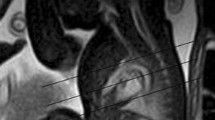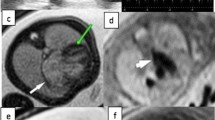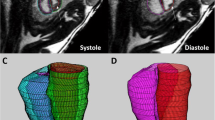Abstract
Fetal echocardiography is the imaging modality of choice for prenatal diagnosis of congenital cardiovascular anomalies. However, echocardiography has limitations. Fetal cardiac magnetic resonance imaging (MRI) has the potential to complement US in detecting congenital cardiovascular anomalies. This article draws on our experience; it describes the transverse aortic arch view on fetal cardiac MRI and important clues on an abnormal transverse view at the level of the aortic arch to the diagnosis of fetal congenital cardiovascular anomalies.












Similar content being viewed by others
References
Loomba RS, Chandrasekar S, Shah PH et al (2011) The developing role of fetal magnetic resonance imaging in the diagnosis of congenital cardiac anomalies: a systematic review. Ann Pediatr Cardiol 4:172–176
Landis BJ, Levey A, Levasseur SM et al (2013) Prenatal diagnosis of congenital heart disease and birth outcomes. Pediatr Cardiol 34:597–605
Trento LU, Pruetz JD, Chang RK et al (2012) Prenatal diagnosis of congenital heart disease: impact of mode of delivery on neonatal outcome. Prenat Diagn 32:1250–1255
Victoria T, Danzer E, Adzick NS (2013) Use of ultrasound and MRI for evaluation of lung volumes in fetuses with isolated left congenital diaphragmatic hernia. Semin Pediatr Surg 22:30–36
Griffiths PD, Porteous M, Mason G et al (2012) The use of in utero MRI to supplement ultrasound in the foetus at high risk of developmental brain or spine abnormality. Br J Radiol 85:e1038–e1045
Gorincour G, Bourlière-Najean B, Bonello B et al (2007) Feasibility of fetal cardiac magnetic resonance imaging: preliminary experience. Ultrasound Obstet Gynecol 29:105–108
Saleem SN (2008) Feasibility of MRI of the fetal heart with balanced steady-state free precession sequence along fetal body and cardiac planes. AJR Am J Roentgenol 191:1208–1215
Manganaro L, Savelli S, Di Maurizio M et al (2008) Potential role of fetal cardiac evaluation with magnetic resonance imaging: preliminary experience. Prenat Diagn 28:148–156
Manganaro L, Savelli S, Di Maurizio M et al (2009) Assessment of congenital heart disease (CHD): is there a role for fetal magnetic resonance imaging (MRI)? Eur J Radiol 72:172–180
Dong SZ, Zhu M, Li F (2013) Preliminary experience with cardiovascular magnetic resonance in evaluation of fetal cardiovascular anomalies. J Cardiovasc Magn Reson 15:40
Votino C, Jani J, Damry N et al (2012) Magnetic resonance imaging in the normal fetal heart and in congenital heart disease. Ultrasound Obstet Gynecol 39:322–329
Yoo SJ, Lee YH, Cho KS (1999) Abnormal three-vessel view on sonography: a clue to the diagnosis of congenital heart disease in the fetus. AJR Am J Roentgenol 172:825–830
Gardiner H, Chaoui R (2013) The fetal three-vessel and tracheal view revisited. Semin Fetal Neonatal Med 18:261–268
Yoo SJ, Min JY, Lee YH et al (2003) Fetal sonographic diagnosis of aortic arch anomalies. Ultrasound Obstet Gynecol 22:535–546
Zidere V, Tsapakis EG, Huggon IC et al (2006) Right aortic arch in the fetus. Ultrasound Obstet Gynecol 28:876–881
Türkvatan A, Büyükbayraktar FG, Olçer T et al (2009) Congenital anomalies of the aortic arch: evaluation with the use of multidetector computed tomography. Korean J Radiol 10:176–184
Rose D, D’Ascoli R, Ventriglia F et al (2013) Double aortic arch: postnatal obliteration of the left aortic arch. Is arterial duct closure responsible? Cardiol Young 29:1–3
Wong SF, Ward C, Lee-Tannock A et al (2007) Pulmonary artery/aorta ratio in simple screening for fetal outflow tract abnormalities during the second trimester. Ultrasound Obstet Gynecol 30:275–28019
Manganaro L, Savelli S, Di Maurizio M et al (2009) Fetal MRI of the cardiovascular system: role of steady-state free precession sequences for the evaluation of normal and pathological appearances. Radiol Med 114:852–870
Wielandner A, Mlczoch E, Prayer D et al (2013) Potential of magnetic resonance for imaging the fetal heart. Semin Fetal Neonatal Med 18:286–297
Gielecki JS, Syc B, Wilk R et al (2006) Quantitative evaluation of aortic arch development using digital-image analysis. Ann Anat 188:19–23
Al Nafisi B, van Amerom JF, Forsey J et al (2013) Fetal circulation in left-sided congenital heart disease measured by cardiovascular magnetic resonance: a case–control study. J Cardiovasc Magn Reson 15:65
Freire G, Miller M, Huhta J (2012) Foetal echocardiography of transposition of the great arteries and common arterial trunk. Cardiol Young 22:671–676
Galindo A, Gutiérrez-Larraya F, Escribano D et al (2007) Clinical significance of persistent left superior vena cava diagnosed in fetal life. Ultrasound Obstet Gynecol 30:152–161
Conflicts of interest
None
Author information
Authors and Affiliations
Corresponding author
Rights and permissions
About this article
Cite this article
Dong, SZ., Zhu, M. Pattern-based approach to fetal congenital cardiovascular anomalies using the transverse aortic arch view on prenatal cardiac MRI. Pediatr Radiol 45, 743–750 (2015). https://doi.org/10.1007/s00247-014-3131-9
Received:
Revised:
Accepted:
Published:
Issue Date:
DOI: https://doi.org/10.1007/s00247-014-3131-9




